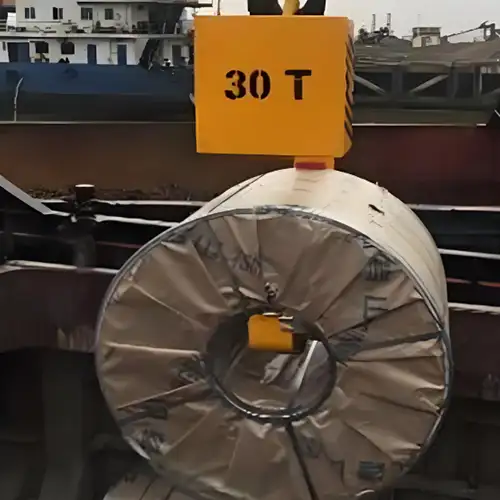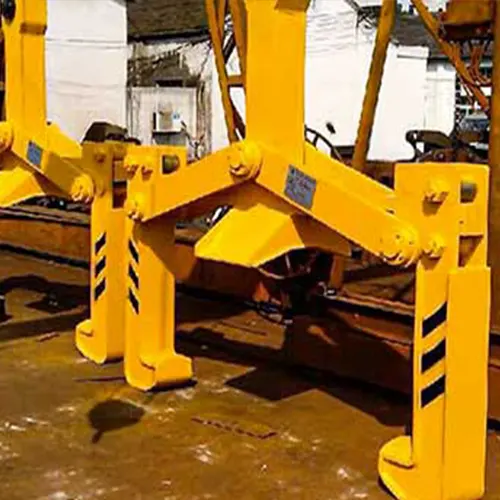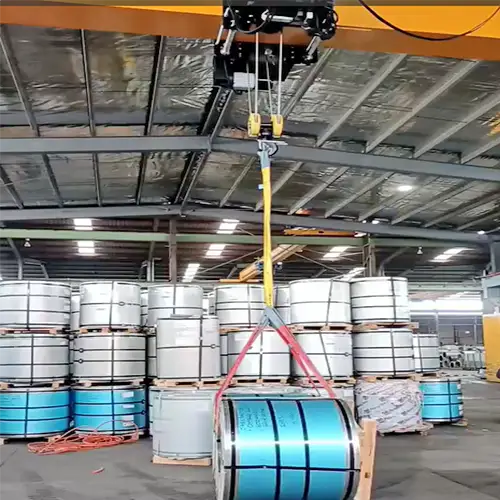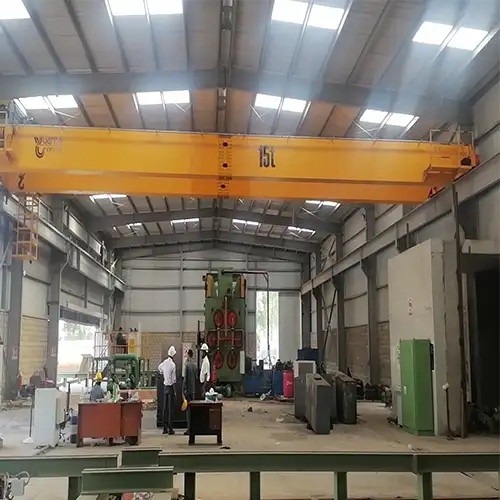How Steel Coil Specifications Affect Overhead Crane Designs
5 to 30 ton overhead cranes for steel coil handling, check how overhead crane is tailored to coil size, weight, orientation & surface protection features.
Category: Featured
Your Trusted Coil Handling Overhead Crane Manufacturer & Supplier
5 Ton to 30 Ton Overhead Cranes for Steel Coil Handling
How Steel Coil Specifications Affect Overhead Crane Designs
Introduction: Lifting Steel Coils the Right Way
Steel coils are everywhere in industrial supply chains. Whether it's for making cars, appliances, or pipelines, these heavy rolls of steel need to be moved—safely and efficiently.
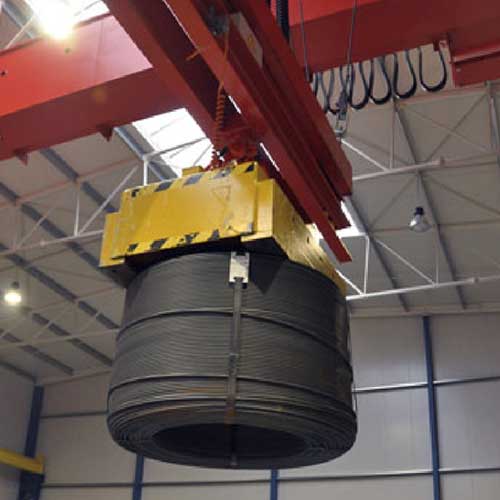
Why Steel Coil Handling Needs the Right Crane
Moving steel coils isn't as simple as it looks. These coils are round, heavy, and sometimes hot. They can weigh anywhere from a few tons to over 30 tons. If not handled correctly, they can cause damage—or worse, serious injuries.
That's where overhead cranes come in. They are widely used in steel mills, processing lines, and coil storage yards. Overhead cranes make it easy to lift, turn, and place coils exactly where they need to go.
- They work above the work area, so no floor space is lost.
- They reach across wide bays and long buildings.
- And most importantly—they do the heavy lifting, so workers stay safe. Click to learn more on steel coil handling magnetic overhead crane.
What's Special About 5 Ton to 30 Ton Capacity Cranes
This capacity range—5 to 30 tons—is common in coil handling.
Here's why:
- 5 to 10 ton cranes are used for lighter coils or smaller lines.
- 10 to 20 tons fits medium-duty operations, like steel service centers.
- 25 to 30 tons is often needed in high-capacity steel mills or ports.
These cranes are strong enough to handle serious loads, but still flexible and cost-effective to install.
Special Tools: Not Just a Hook and Go
Steel coils can't be picked up like boxes. You need the right tools on the crane hook.
Some common ones include:
- Coil tongs: These clamp the coil from both sides. Good for eye-to-eye lifting.
- C-hooks: Shaped like a "C", they slide through the coil center (eye-to-sky).
- Motorized grabs: Adjustable and powered to lift different coil sizes.
- Rotators: Help rotate the coil if it needs to be turned or reoriented.
These tools are mounted to the crane's hook or trolley, depending on what the job needs. Choosing the right one depends on how the coil is packed, stored, and moved.
Overview of Steel Coil Specifications
Steel coils come in many shapes and sizes. These differences affect how they are lifted and moved. Understanding coil specifications is important when choosing the right crane and lifting tools.
Common Sizes and Weights
Steel coils are not one-size-fits-all. Their dimensions can vary based on how they're produced and used. Below are the key measurements to consider:
- Outer Diameter (OD): Usually between 800 mm and 2,200 mm.
- Inner Diameter (ID): Common sizes are 508 mm and 610 mm. This size affects the type of hook or tong you'll need.
- Width: Can range from 600 mm to over 2,000 mm. Wider coils need tools with a wider grip span.
Weight per Coil:
- Light coils weigh around 5 tons.
- Medium coils range from 10 to 20 tons.
- Heavy-duty coils can go up to 30 tons.
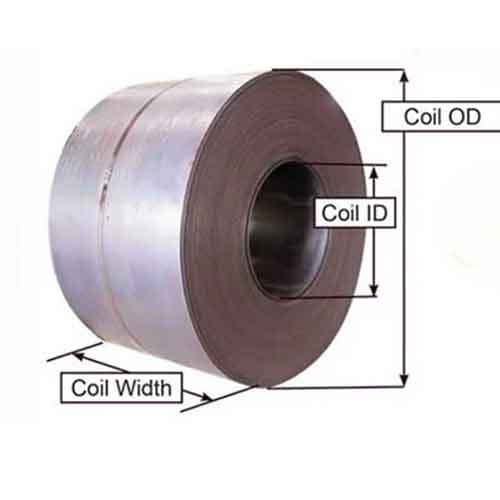
Even a small difference in coil size or weight may change the design of the lifting tool. Always confirm the full size range when planning your crane system.
Surface Conditions
Steel coil surfaces vary depending on how they are finished. Each surface type has different handling needs.
- Hot-Rolled Coils: These have a rough surface and may include mill scale. They are a bit more durable during lifting and can tolerate more contact.
- Cold-Rolled Coils: These have a smooth finish. They are often used for visible or precise applications. Handling must be gentle to avoid scratching or denting.
- Galvanized or Coated Coils: These coils have protective surface layers. Any damage to the coating can reduce the value of the coil. Handling tools should have soft padding or non-marking materials to protect the finish.
If coils have a high surface finish requirement, it's not just about lifting capacity. The lifting method and contact surfaces matter just as much. Damage during lifting can lead to product loss or customer complaints.
Packaging and Orientation
Steel coils may be delivered, stored, or processed in different orientations, depending on the operation. The coil's orientation—how the eye (center hole) is facing—determines what kind of lifting attachment is suitable. This factor must be considered early in crane planning.
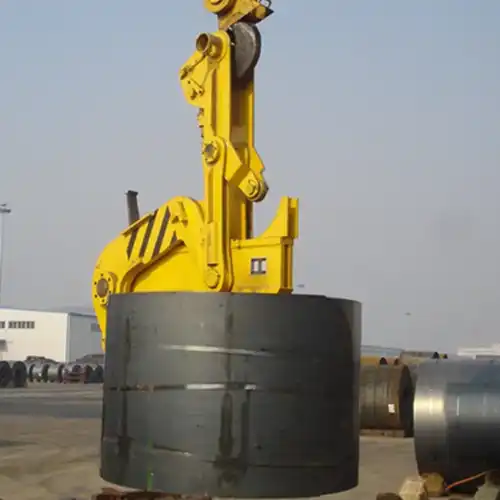
In this orientation, the coil is placed flat on its side with the center hole pointing upward—like a donut lying on a table. It's common for long-term storage, inventory stacking, or loading onto vertical coil cars.
Handling Tools Used:
- C-hooks that insert through the eye and cradle the coil.
- Vertical coil tongs designed to grip the coil's interior and lift straight up.
Design Considerations:
- Requires vertical clearance for hook entry and exit.
- Coil needs to remain balanced and steady during lifting.
- Coil diameter must match the C-hook's reach or tong span.
Typical Environments:
- Warehouses and storage yards.
- Rolling mill output areas where coils are stacked.
- Export preparation zones.
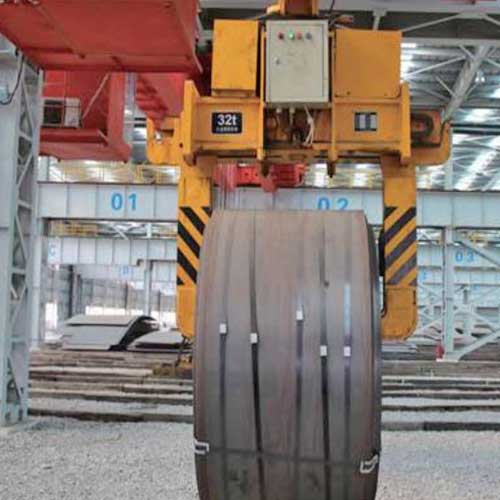
Here, the coil is set upright like a wheel, with the eye facing outward. This is the typical orientation used on production lines, especially in slitting, cutting, or galvanizing processes.
Handling Tools Used:
- Horizontal coil tongs that grip the sides of the coil.
- Motorized coil grabs with adjustable arms.
- Rotating hooks or lifting beams that can reorient the coil mid-air.
Design Considerations:
- Requires side grip strength and secure alignment.
- May involve motorized rotation for reorienting coils on the fly.
- Must account for surface protection, especially with finished coils.
Typical Environments:
- Continuous coil processing lines.
- High-throughput logistics or coil delivery systems.
- Automated or semi-automated coil handling setups.
Crane buyers often overlook this detail. A crane designed for eye-to-sky coils may not work safely or efficiently for eye-to-side coils—and vice versa. If your operation handles both orientations, a rotating attachment or modular lifting system may be the best choice.
Typical Handling Requirements
Lifting a heavy steel coil is only part of the job. In most industrial setups, overhead cranes must also handle precise movement, rotation, and placement. Poor handling increases the risk of damage, safety incidents, and production delays.
Precision Placement
Steel coils are often loaded into machines, stacked tightly, or placed on coil cars. Accurate positioning is key.
- Cranes should offer variable hoisting speeds for smooth up-and-down movement.
- Trolleys and bridge travel should allow fine motion control, especially in tight spaces.
- Remote control or cabin operation lets the operator position coils exactly where needed.
Coil Rotation
Some operations need coils to be turned during transport. For example, a coil may arrive eye-to-side but must be stored eye-to-sky.
- Motorized rotators or coil turning devices can rotate the load without extra equipment.
- Rotation functions can be integrated into the crane hook or lifting beam.
- This reduces the need for forklifts or manual re-handling, saving time and labor.
Stacking
In storage yards or warehouses, coils are stacked vertically (usually eye-to-sky). The crane must maintain a stable vertical lift and avoid swaying to prevent tipping or unbalanced stacks.
- Anti-sway systems help minimize load movement.
- Hoist and trolley braking systems should ensure gentle starts and stops.
- Operators need clear visibility or camera support for exact stacking.
Safe, Space-Efficient Storage
Space is limited in most coil storage areas. Coils are usually placed close together to maximize floor usage. Mistakes in placement can cause safety hazards or force re-handling.
- A crane system with accurate control and smooth motion helps place coils precisely.
- For automated or semi-automated yards, positioning sensors and preset memory points can assist with repeatable coil drops.
- Proper layout design and working clearance must be considered when choosing span and lifting height.
Handling steel coils requires more than just a strong hook. The crane must deliver smooth, steady, and accurate movement. Whether it's placing coils between others, rotating their orientation, or stacking them tightly in a yard, your crane system should be designed for the full handling process—not just the lift.
Design Features for Safe Coil Handling
Handling steel coils safely requires more than just lifting capacity. The crane's design must focus on specialized attachments, precise control of hoisting speeds, and systems that keep the load steady during movement. Below are key features that help protect the coil, the operator, and the facility.
Coil-Specific Lifting Attachments
The right lifting tool is crucial for gripping coils securely without damaging the steel surface. Different attachments serve different coil sizes, orientations, and handling needs.
- Motorized Coil Grabs with Adjustable Arms
These grabs have powered arms that open and close around the coil automatically. Adjustable arms mean they can fit various coil widths and diameters. Motorized grabs improve safety by removing the need for manual adjustments and provide consistent gripping force.
C-Hooks and Tongs
- C-Hooks: Ideal for eye-to-sky coils. They slip into the coil's center and cradle the weight from underneath.
- Tongs: Can be mechanical (manual or spring-loaded) or motorized. They grip the coil from the side or top and are useful for different coil orientations. Motorized tongs offer better control and reduce operator effort.
- Eye-to-Side Hooks: Specialized hooks designed for lifting coils oriented with the eye facing sideways.
Rotators (Optional but Recommended)
Some operations require reorienting the coil mid-air—such as changing from eye-to-side to eye-to-sky. Rotators attached to the crane hook allow the coil to be turned smoothly without extra handling equipment, saving time and reducing risk of damage.
Using the correct lifting attachment ensures the coil is handled firmly and safely, avoiding slippage or surface scratches.
Hoisting Mechanism and Speed Control
Smooth control of the lifting motion is vital to protect heavy coils from impact forces and deformation.
- Variable Hoisting Speeds- Cranes should allow the operator to choose different lifting speeds based on the task. Fast speeds can be used for moving empty hooks or light loads, while slow, controlled speeds are necessary during precise placement.
- Two-Speed or Frequency Inverter (VFD) Hoists- Many modern cranes use Variable Frequency Drives (VFDs) that enable smooth acceleration and deceleration instead of abrupt starts and stops. Two-speed hoists offer basic speed options but VFDs provide fine control and energy efficiency.
- Controlled Acceleration and Deceleration- Gradual starts and stops prevent shock loading—the sudden forces that can damage coils or stress crane components. This is especially important when handling coils near other equipment or stacks, where jerky movements could cause accidents.
Proper hoist speed control extends equipment life, reduces maintenance, and helps keep the coil surface flawless.
Anti-Sway and Positioning Systems
Load sway is a major safety and operational concern when lifting heavy steel coils, especially during long travel or high-speed trolley movement.
- Anti-Sway Controls
These systems actively reduce the swinging of the load using mechanical dampers or electronic controls that adjust the crane's motion. This keeps the coil steady during acceleration, deceleration, and travel, reducing the risk of collisions or dropped loads. - Sensors and Automation (Optional)
More advanced cranes are equipped with sensors that monitor load position and travel speed. Automation systems can assist operators by limiting sway, correcting path deviations, or even performing semi-automatic positioning. - Position Feedback and Operator-Assist Systems
Feedback devices give the operator real-time information about hook location, height, and load swing. Some cranes feature operator-assist controls that help slow or stop motion automatically when close to a preset position, improving accuracy during placement.
These systems are especially important in busy steel mills or warehouses where space is tight and safe, precise coil handling is mandatory.
Choosing the right design features is essential for safe, damage-free coil handling. Motorized grabs and rotators provide secure and flexible lifting. Smooth, variable hoisting protects coils from shocks. Anti-sway and positioning technologies keep the load stable and the operation precise. Together, these features improve safety, productivity, and equipment longevity.
How Coil Specifications Affect Crane Design
Steel coil specifications are key factors that shape the entire design of an overhead crane system. From the crane's lifting capacity to the type of attachments, every detail must match the coil's size, weight, and handling needs. Here's how important coil specs influence crane design choices.
Coil Weight: Determines Capacity, Hook Path, and Beam Strength
- Crane Lifting Capacity
The first and most obvious factor is the coil's weight. Heavier coils require cranes with higher rated capacities. A coil weighing 30 tons needs a crane designed and tested to lift safely above that weight with a good safety margin. - Hook Path and Clearance
Heavy coils also affect how the hook and hoisting mechanism are positioned. The hook path must allow enough clearance so the coil can be lifted, moved, and placed without hitting other structures. - Bridge Beam Strength
The main girder or bridge beam must be strong enough to carry the coil weight plus the dynamic forces caused by crane movement. This means thicker beams, better welding, and sometimes additional reinforcement for heavy-duty cranes.
Coil Size: Influences Trolley Width, Hook Travel, and Grab Opening
- Trolley Width
Larger diameter coils require a wider trolley to ensure the lifting hook or grab can be positioned correctly over the coil's center. - Hook Travel (Horizontal Movement)
The crane must allow the hook or lifting tool to travel across the coil's full width. For wide coils, a longer runway or wider bridge span may be necessary. - Grab Opening Width
For grabs and tongs, the arms must open wide enough to securely hold the coil without slipping or causing damage. Adjustable grabs are preferred when coil sizes vary.
Handling Orientation: Affects Type of Lifting Tool and Rotation Mechanism
- Eye-to-Sky or Eye-to-Side
Coils may be stored and lifted in different orientations. Eye-to-sky coils require lifting tools like C-hooks or coil grabs designed to support the weight vertically through the coil's eye. Eye-to-side coils need tongs or side hooks that grip from the coil's outer diameter. - Need for Rotation
If coils must be turned during handling (e.g., from eye-to-side to eye-to-sky), the crane must include a rotator mechanism. This is often a motorized device attached to the hook, allowing smooth and safe rotation without manual intervention.
Surface Protection: Non-Scratch Materials on Lifting Tools
- Many steel coils have delicate finishes such as galvanized or cold-rolled surfaces. Damaging these surfaces during lifting means rework or scrap.
- Lifting attachments must use non-scratch materials like rubber padding, nylon coatings, or specially treated metal surfaces. This protects the coil surface while maintaining a firm grip.
- Regular inspection and maintenance of these protective layers are necessary to avoid wear that could expose the coil to damage.
Storage Layout: Influences Crane Span, Lifting Height, and Bridge Speed
- Crane Span
The layout of the storage yard or warehouse dictates the span of the crane. Wide storage aisles or multiple storage rows require a longer bridge to cover the entire area. - Lifting Height
High stacking of coils requires cranes with sufficient lifting height and hook travel to place coils safely on top of stacks. - Bridge and Trolley Speed
In fast-paced operations, higher bridge and trolley speeds reduce cycle times, increasing productivity. However, higher speeds require better anti-sway controls to maintain safety. - In smaller or less busy yards, slower speeds may be acceptable and reduce wear on crane components.
5 to 30 Ton Overhead Cranes for Steel Coil Handling
Understanding Capacity Categories and Matching the Right Crane for the Job
Steel coils vary greatly in weight and size. The overhead crane must match the lifting demand—not only in terms of weight but also the handling method, duty cycle, and the type of attachment used. Below is a breakdown of what to expect in different capacity ranges.
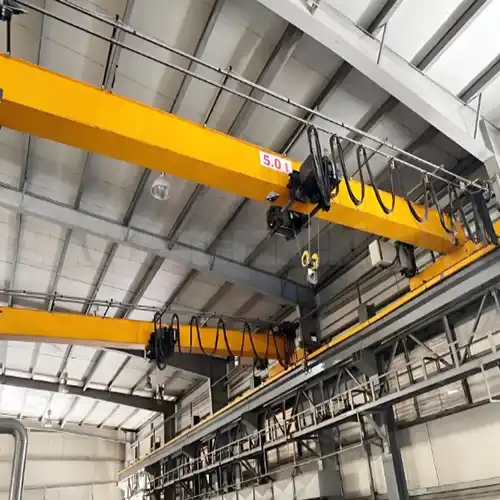
This range is often used for smaller coils, lighter materials, or facilities with lower production throughput. It is also common in smaller service shops or as part of a secondary lifting system in larger plants.
Typical Applications:
- Handling cold-rolled or coated coils with weights up to 10 tons
- Loading and unloading coil slitting or decoiling machines
- Moving lighter steel coils in distribution warehouses or fabrication shops
- Occasional coil repositioning or storage work
Lifting Attachments Commonly Used:
- Basic C-Hooks
Simple and cost-effective. Can lift coils by inserting into the eye, especially for eye-to-sky orientation. - Mechanical Coil Tongs
Manual or spring-loaded devices that grip the coil without power input. Suitable where power supply to the grab is not available.
Design Considerations:
- May not require full automation or advanced controls.
- Ideal for use in environments where coils are handled only a few times per hour.
- Compact hoists and low-headroom cranes are often chosen to fit into smaller facilities.
- Smooth starts and stops are still important to prevent coil surface damage.
This range is a smart option for buyers looking to manage costs while still meeting basic coil handling needs.
Medium to Heavy Duty Range: 10–30 Ton
This is the most common range for high-volume steel coil handling. Facilities that process large coils daily—like steel service centers, cold rolling mills, or logistics hubs—rely heavily on cranes in this class.
Typical Applications:
- Lifting hot-rolled coils from production lines
- Stacking or loading export coils in warehouses or ports
- Feeding processing lines such as galvanizing or pickling lines
- Rapid and repeatable lifting cycles in shift-based operations
Advanced Lifting Attachments:
- Motorized Coil Grabs
Electrically powered devices that open and close gripping arms automatically. These offer safer, hands-free operation. - Rotating Lifting Beams or Grabs
Allow the operator to rotate the coil mid-air, changing from eye-to-side to eye-to-sky orientation as needed. - Custom Coil Lifters with Surface Protection
Padded or coated grab surfaces prevent scratching on finished or coated coils.

Design and Performance Features:
- Dual-Speed or Inverter-Controlled Hoists
Essential for safe and smooth lifting, especially when handling high-value coils. - Anti-Sway Controls
Reduce swinging during acceleration, deceleration, or directional changes. Especially critical for tall or narrow coil stacks. - Remote Operation or Cabin Control Options
Provide better visibility and more accurate coil placement, especially in large or crowded yards. - High Duty Ratings (e.g., FEM 3m or 4m)
Designed for frequent starts, stops, and longer daily usage.
In this capacity class, safety and efficiency are top priorities. Investing in better control systems and durable lifting attachments pays off over time, especially in plants running 2 or 3 shifts per day.
Choosing between a 5-ton and a 30-ton overhead crane isn't just about weight—it's about workflow, volume, and future demand. Under-sizing may slow your operation; over-sizing may raise costs unnecessarily. Get a clear understanding of your coil sizes, handling frequency, and desired speed before selecting your crane system.
Safety Features and Operator Considerations
Safety is a top priority when handling heavy steel coils with overhead cranes. Proper safety systems protect operators, equipment, and materials from accidents and damage. At the same time, operator comfort and control options play a big role in efficient, precise, and safe crane operation. Let's look at the key safety features and operator-related factors.
Overload Protection and Emergency Stop Systems
- Overload Protection
Cranes must have built-in systems to prevent lifting beyond their rated capacity. Overload devices monitor the load weight in real time. If the load exceeds safe limits, the system triggers alarms or automatically stops lifting. This prevents structural damage and dangerous failures. - Emergency Stop (E-Stop) Systems
Easily accessible emergency stop buttons are essential. They allow operators or nearby personnel to immediately halt crane motion in case of any unsafe condition. E-stop buttons should be present in the crane cabin, on pendant controls, and remote controllers.
Visual Indicators and Alarms
- Load Indicators
Real-time load weight displays keep the operator informed, so they never accidentally overload the crane. - Position and Limit Indicators
These show the crane's position on the runway and alert when the crane is near operational limits, preventing crashes or collisions. - Audible and Visual Alarms
Warning alarms notify operators and surrounding workers of crane movement, overload, or system faults. Visual lights and audible sounds improve awareness, especially in noisy environments.
Cabin Control vs. Remote or Pendant Control Options
- Cabin Control
Traditional crane cabins give operators full control with a clear view from a protected space. This is suitable for large or long-duration lifting operations where operator comfort is important. - Pendant Controls
Pendant controls are wired hand-held devices that allow the operator to stand closer to the load or on the ground. They offer good control but limit operator movement to the cable length. - Remote Controls
Wireless remote controls give operators freedom to move around the site for better viewing angles. This is particularly helpful when visibility from the cabin is limited or when the operator needs to monitor multiple areas.
Choosing the right control option depends on the work environment, visibility needs, and operator preference.
Operator Visibility and Safe Working Distances
- Clear Line of Sight
The operator must have a good view of the load and the surrounding area to avoid collisions. Cabins are often elevated or fitted with large windows. Cameras and monitors can supplement visibility in blind spots. - Safe Working Distances
Controls and operational areas should keep the operator safely away from moving parts and suspended loads. This reduces risk in case of unexpected load swings or crane malfunctions. - Ergonomics and Comfort
Comfortable seats, climate control, and vibration dampening in cabins reduce operator fatigue. Less fatigue means better focus and safer operation.
Good safety features and thoughtful operator considerations go hand-in-hand. Overload protection and emergency stops prevent accidents before they happen. Clear visual and audible signals keep everyone aware. Providing control options that suit the worksite and ensuring operators can see clearly and work comfortably improves safety and productivity.
Typical Applications-Steel Service Centers
Overhead cranes designed for steel coil handling find their place in many industrial environments. Each setting has its own unique demands, influencing crane features like capacity, speed, and attachments. Here's a look at the main applications where these cranes play a critical role.
Steel Service Centers
- Service centers receive, store, and prepare steel coils for delivery or further processing.
- Cranes here handle coils frequently, moving them between trucks, storage racks, and processing machines.
- The cranes need to be versatile, handling a range of coil sizes from light to heavy.
- Fast, smooth operation with precise control is vital to keep production flowing and avoid coil damage.
- Features like motorized grabs and rotators help operators quickly reposition coils for slitting, cutting, or rewinding.
Coil Storage Yards and Warehouses
- Storage yards often have large stacks of steel coils organized for easy access.
- Cranes must have sufficient lifting height and span to place coils safely on high stacks or retrieve them.
- Because coils are stored for varying times, careful handling to prevent surface damage is critical.
- Anti-sway systems and precise positioning controls help in tight stacking areas.
- In warehouses, space constraints may require cranes with compact designs and flexible lifting attachments.
Steel Production Lines and Coil Processing Plants
- In mills and processing lines, coils move continuously through various stages—coiling, inspection, treatment, and packing.
- Overhead cranes need high durability and speed to keep pace with fast production lines.
- Precise control systems ensure coils are handled safely without interrupting processes.
- Some cranes include automation features or remote control to improve operator safety in hazardous environments.
- Coil rotators are essential here for adjusting coil orientation between processes.
Port and Logistics Terminals Handling Steel Coils
- Ports are hubs where steel coils arrive or leave by ship, rail, or truck.
- Cranes must handle heavy loads (up to 30 tons or more) efficiently and safely in outdoor, often harsh conditions.
- Robust weatherproof designs and protective covers for hoists and electrical components are important.
- Handling large volumes quickly requires powerful hoisting mechanisms and high bridge speeds.
- Remote control and anti-sway features help operators work safely from a distance amid busy terminal activity.
Each application area has distinct needs, but all rely on cranes that safely handle heavy steel coils with precision and care. Whether in a busy steel mill, a crowded storage yard, or a logistics terminal, the right overhead crane ensures smooth operations, protects valuable steel products, and keeps workers safe.
Summary and Buyer Takeaways
Choosing the right overhead crane for steel coil handling isn't just about picking a capacity number. It involves understanding your coils, the way you handle them, safety needs, and the long-term reliability of your equipment. Here are the key points to keep in mind when selecting a crane from 5 to 30 tons.
Know Your Coil Specifications and Handling Methods
- Coil size and weight set the foundation for crane capacity and design. Lifting too heavy or too large a coil with the wrong crane risks accidents and damage.
- Handling orientation — whether eye-to-sky or eye-to-side — determines the type of lifting attachments needed, like grabs, tongs, or hooks.
- The surface condition of coils calls for protective materials on the lifting tools to avoid scratching or denting.
- Consider your storage layout and operational workflow to pick crane spans, lifting heights, and travel speeds that fit your site.
Safety and Control Systems Are Essential
- Always prioritize cranes equipped with overload protection, emergency stops, and anti-sway controls.
- Decide on the best control option for your operation — whether it's a cabin, pendant, or remote control — based on operator visibility and site conditions.
- Visual and audible indicators help operators stay aware and respond quickly to unsafe situations.
Custom Solutions for Your Specific Needs
- Off-the-shelf cranes rarely fit perfectly. Look for manufacturers who offer customized crane designs and lifting attachments tailored to your coil specs and handling methods.
- From simple 5-ton cranes to heavy-duty 30-ton systems, expert engineering support ensures your crane works efficiently and safely from day one.
- Customization extends to features like motorized coil grabs, rotators, smooth hoist speed controls, and integration with your facility's automation or safety systems.
Optional Section: Inquiry Checklist
Before contacting a crane supplier, consider the following questions to help define your requirements clearly:
1. What are the dimensions and weights of the steel coils you handle?
- Typical outer diameter: ___________
- Inner diameter: ___________
- Width: ___________
- Weight range (min to max): ___________ tons
2. How are your coils oriented during lifting?
- Eye-to-sky (vertical) ☐
- Eye-to-side (horizontal) ☐
- Do you need rotation capabilities? Yes ☐ No ☐
- Any special handling (stacking, precise placement, bundling)? Please describe: ___________
3. Will the crane be used indoors or outdoors?
- Indoor ☐
- Outdoor ☐
- Environmental conditions to consider (e.g., temperature, dust, moisture): ___________
4. What is the expected duty cycle?
- How many lifts per hour/day? ___________
- Is it light, medium, or heavy-duty use? ___________
5. Which lifting attachments do you prefer or currently use?
- Coil tongs (mechanical/motorized) ☐
- C-hooks ☐
- Coil grabs with adjustable arms ☐
- Eye-to-side hooks ☐
- Any surface protection needed on attachments? Yes ☐ No ☐ Please specify: ___________
6. Where will the crane be installed?
- Country/region: ___________
- Are certifications required? (e.g., CE, ISO) Please specify: ___________
Related Products
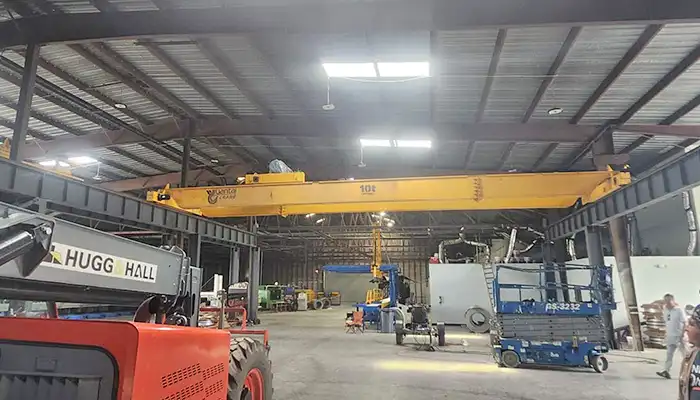
Affordable 10 ton double girder overhead crane with CD/MD hoist trolley, built for U.S. standards, ideal for construction and industrial lifting
Free consultation to Confirm Parameters & Specifications and Get
Latest Crane Price & Crane Rate.
- Types of overhead cranes : _______?
- Optional: Overhead travelling crane, goliath gantry crane,Slewing jib crane, Single girder or double girder crane,small portable crane or kbk crane, etc.
- Capacity of overhead crane: _______?
- Optional: 0.25ton, 0.5 ton, 1 ton, 2 ton, 3ton, 5 ton, 10 ton,15ton, 20ton, 25 ton, 30ton,35ton, up to 550ton, etc.
- Crane span & lifting height : _______?
- Crane travelling length : _____?
- Control of overhead crane:_______?
- Optional: pendant/ remote/cabin control
- Voltage supply of overhead crane:_____?
- Eg,: 380V50/60HZ,3Phase or others,etc.
- Application/usage of crane:_______?
- Eg,: Steel mill, ,injection mold, cement,stone, concrete,granite, general manufacturing, etc.
Just leave a message via the contact form and our hoist and crane engineer will contact you with in 24working hours.
Get In Touch
